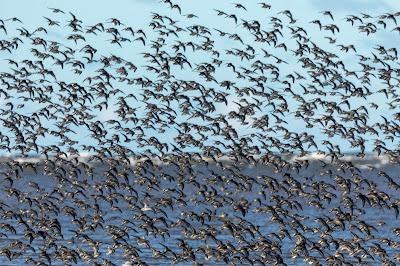One of the things I like about living where I do is the fact that I am so close to the sea and the abundance of wildlife that comes with that.
A walk along the shore line reveals a myriad of shells; cockles, mussels, razor clams, whelks, winkles and more. There are egg casings known as "mermaids purse" from skates, rays and dog fish, other egg cases and sometimes starfish or jelly fish left behind by the receding tide. Further out in the rock pools around Hilbre Island there is all manner of life including small fish, crabs, anemones, shrimp etc and beyond that on the sand bank out in the estuary there is a large colony of Grey Seals. All this diversity of wildlife is amazing but much of it goes unnoticed unless you are looking for it.
What cannot be so easily overlooked however is the vast array of waders and shore birds that live here or visit as migratory species. The rich food stocks draw in thousands of birds and as the tides come and go the shoreline is visited by Sandpipers, Oystercatchers, Dunlin, Knot, Plovers, Wagtails and Buntings and many more. Along the creeks you will often see Egrets and Herons too.
Even though I live so close I don't get to spend as much time enjoying and exploring as I would like and if nothing else in the year ahead I think I will try to make more time to explore what is almost literally on my doorstep.
I look at posts on social media from friends in different parts of the world and often think that I would be spoilt for opportunities to see wonderful things if I lived in any of those places but I have so much close to home I need to make more time to see that. It doesn't stop me wanting to travel and explore further afield of course but I will try to look more closely at what is nearby.
So for today's offering I have chosen a few shots taken on a resent walk on the beach. I followed the tide out about half a mile to a spot where I could see a large flock of birds gathering. They appeared to be arriving in waves and then settling where they found a raised bank of sand. As I got closer the sound was incredible as thousands of birds were chattering to each other. Some were feeding, like the Sanderling in the first shot which was moving so fast through the shallow water, but others were settled with their heads tucked under their wings perhaps sleeping or just sheltering from the icy wind coming off the Irish Sea. In the second image you can see Sanderlings in the foreground while the out of focus background is comprised of a large flock of Common Sandpipers.
It is hard to describe how vast the flock was but every now and then a large group would lift off and then find a different spot to settle, as they took to the air there was a fantastic sound of thousands of wings beating in unison. It was quite an experience to be faced with a wall of wings and feathers.














